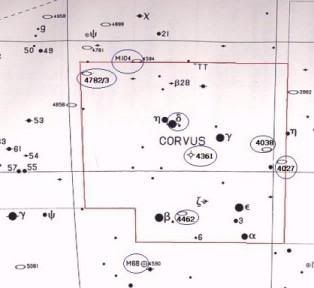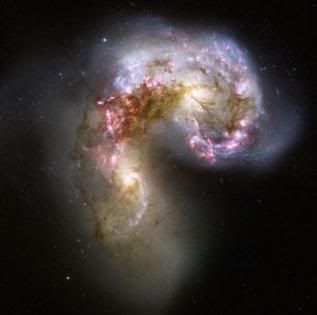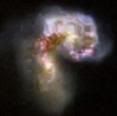Post by glactus on Feb 17, 2008 8:58:27 GMT


Corvus lies in the direction of the distant Sagittarius Arm, but somewhat 'above' the plane of the Milky Way.
Although there are no messier objects in this small area of the cosmos, the Antennae galaxies provide one of the most striking photographic images in the sky, and there is a lot going on there, so we must include its presence as we journey through the constellations.
The Antennae Galaxies, also known as NGC 4038 and NGC 4039, are a pair of galaxies about 68 million light years away in this constellation.
The center of Corvus is also home to a Planetary nebula NGC 4361. The nebula itself resembles a small elliptical galaxy, but the magnitude 13 center star gives away its true nature.
This constellation also houses another pair of remote interacting galaxies, NGC 4782 and NGC 4783. They are a long way from us at 170 million light years and have a magnitude of 12.4.

Antennae NGC 4038 / 4039
As you read, the Antennae are undergoing a galactic collision. Located in the NGC 4038 group with five other galaxies, these two galaxies are known as the 'Antennae' because the two long tails of stars, gas, and dust thrown out of the galaxies as a result of the collision resemble the antennae of an insect.

An image of the tail of both galaxies
The nuclei of the two galaxies are joining to become one supergalaxy. NGC 4038 is at the top, and NGC 4039 is at the bottom.
About 1.2 billion years ago, the Antennae were two separate galaxies. NGC 4038 was a spiral galaxy and NGC 4039 was a barred spiral galaxy. Before the galaxies collided, NGC 4039 was larger than NGC 4038.
900 million years ago, the Antennae passed through each other, and 300 million years on, the Antennae's stars began to be released from both galaxies. Today the two streamers of ejected stars extend far beyond the original galaxies, making the antennae shape.
The Galaxies will eventually form an elliptical galaxy

credits:
corvus map:
www.angelfire.com/ky/astronomers/Corvus.html
Images and text:
www.answers.com/topic/antennae-galaxies


